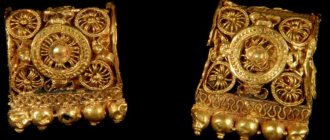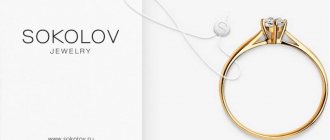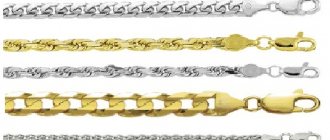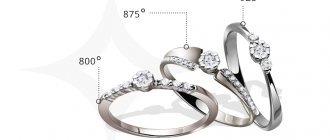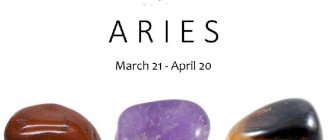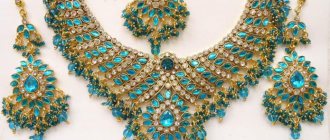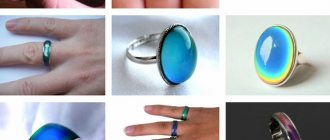Jewelry art of Ancient Rus'.
Temporal rings or Useryaz are very famous jewelry items among the ancient Slavs , which at the same time served as amulets and amulets. There are a great variety of types of temporal rings, and no less of them have been found than lunar rings. Temple rings were women's jewelry that were woven into the hair at the temples. There were often several of them, the number reaching six or more. Bronze, silver, and gold items are found. Often beads were strung on rings - amber, glass, stone, and once archaeologists even came across a cherry pit. They are found almost all over the world, starting from the layers of the Bronze Age. Some were even found during excavations of the legendary Troy. But the largest number was discovered on the territory of ancient Rus' in the 8th-12th centuries, so it is the Slavs who are credited with the special flourishing of such jewelry. They are found both in village mounds and in large cities.
Jewelry at that time had two purposes at once. The first is beauty, and that is why women have always had much more jewelry and various pendants, rings, earrings, etc. than men. In ancient times, women were treated with almost reverence. In ancient times, a woman was not only a woman in labor who must bear and raise offspring, but also a priestess at the temples, a knowledgeable mother, a keeper of magic, a prototype of the Mother of the Raw Earth in human form. The second is the ritual and religious meaning.
In Ancient Rus' there was a belief that evil spirits could influence any person if he was not protected by special amulets. The body is always protected by a shirt, a dress with protective symbols embroidered on them, bracelets on the wrists, necklaces on the neck, a special bandage on the forehead, and the temples, like a naked place, were protected with just such rings.
Unfortunately, the term by which these amulets were called in ancient times has not reached our days, and their name is only the assumption of scientists.
From some sources (Dahl's Dictionary, church lists) we can find out that the temple rings were called “ Useryaz ” - ear decoration, earring, temple.
As already mentioned, a wide variety of species of temporal rings was found during excavations. However, wire rings are the most widely used (most likely due to their low cost and ease of manufacture). The wire rings were of small diameter with the ends wrapped in loops. Also widespread were head rings on which pendants in the form of a grapevine were attached; two- and three-bead rings; seven-rayed, bracelet-shaped. All rings are divided into several types: wire, bead, shield, beam, blade. In ancient times, by the appearance of the temporal rings, it was possible to very easily distinguish representatives of different tribes, as well as the position of the girl/woman in society.
Wire:
Seven-ray rings. Seven-rayed, like others, are divided into several subspecies: Temporal rings with a smooth shield or classic, Temporal rings with an arch on the shield and with five denticles along the upper edge of the shield, Temporal rings with rays in the form of a trefoil and with an ornamented shield or Desninsky type. Ray and blade decorations were cast.
Five-point rings:
Bracelet-shaped rings. These are wire rings that had a crescent shape and knotted ends.
Scutellaceae and Rhomboscutaceae. Such rings are most often found in the settlement areas of the Ilmen Slovenes. Bronze rings, where there are thickenings in the form of rhombuses from 2 to 5 pieces. They were made from wire, which was forged into plates. Over time, the patterns on the shields changed and this is what helped archaeologists and historians determine how the tribes settled. Openwork and very filigree works of ancient Slavic craftsmen are often found.
Do you knit or sew clothes? Do you have your own workshop or craft store? Please note that you can buy yarn wholesale in the Vultex online store. Large selection of yarn and knitting needles with delivery.
Blade:
Beaded. They are distinguished into single-bead, three-bead and multi-bead.
Curly and lunate-shaped (lunar) temporal rings. Lunnitsy absorbed both elements of curly rings and women's jewelry, which were called Lunnitsa.
Scientists claim that such decorations are not originally Slavic. Long before this, they were used throughout Europe, in Scandinavia and Byzantium. The Slavs, sometimes encountering other peoples, over time adopted the decorations for themselves. And yet, the temple rings that our ancestors used are very different from the rings of other peoples, since the Slavs gave them a special personality, taking into account their beliefs and traditions. By the 8th century, these rings were already considered typically Slavic jewelry.
In most cases, researchers believe, the temple rings were woven into the hair, but were also suspended from the corolla, a girl’s headdress. In addition, entire necklaces were made from rings, which framed the entire head or were strung on a strap and encircled the head. In the case when the temple rings were attached to the headdress, they were not located near the temple, but at the level of the ears and seemed to cover them. In some places such products were even inserted into the earlobe, like earrings.
It is also interesting how the temple rings were worn depending on the age of the girl or woman. Girls and teenagers practically did not wear rings or wore simple ones, hand-bent from wire. Grown-up girls, brides and mature women wore the best rings at their temples. Older women refused rings, apparently in favor of simply passing them on to a new generation.
Temporal rings were woven into the hair something like this: the hair was combed in a straight parting from the back of the head to the temples. After this, pigtails were braided on both sides, approximately the thickness of the little finger. The pigtail went from the temple behind the ear and consisted of three strands. The first ring, the smallest one, was woven into the upper weave of the braid near the temple, and the next one, which was larger, was woven a little lower. Up to four rings could be woven this way.
Beginning of dawn
The eighteenth century was very significant for Russia; almost all spheres of social life felt the reforms of Peter I. First of all, radical changes occurred in the appearance of people, we are talking about clothing and, therefore, jewelry.
In 1700, Peter issued a decree introducing city costume. In Western Europe, such a law was already in effect, but in Russia this process was very slow and painful, although in the end it became firmly established in the life of court society. Women were supposed to wear figure-hugging dresses with a deep neckline, and men wore camisoles, caftans, short trousers, stockings and shoes with buckles. Both women and men were required to wear a wig on their heads.
In 1721, Russia became an empire, and the ceremony of crowning the kingdom was replaced by coronation. In this regard, new regalia appeared in Russia, the “Monomakh Cap” was replaced with a crown. Thus, for the coronation of Catherine II, a crown was made, which became a real masterpiece of Russian jewelry. It was made by jeweler Jeremiah Pozier. The crown was decorated with five thousand diamonds of various colors: colorless, pink and yellowish, having a wide variety of shapes. Two rows of perfectly smooth Indian pearls, which added volume to the shape and gave a special shine to the diamonds. The top of the crown is decorated with a deep red spinel of 398.72 carats and is braided with a branch of diamonds.
Jewelry of great luxury was also made for church hierarchs. For example, the panagia granted by Catherine II to Metropolitan Dmitry was decorated with a small oval medallion with the composition “Coronation of the Mother of God.” The medallion is made of multicolor enamel, framed by an openwork diamond wreath, tied with a bow at the top. On the reverse side of the panagia is a portrait of Catherine II. There are suggestions that this masterpiece was made by the same jeweler, I. Pozier, who made the crown for the Empress. The master received 5,600 rubles for his work. At that time it was a lot of money. For example, a yard girl was worth 100 rubles, someone trained in some kind of craft was worth 200 rubles, and a strong serf guy was valued at 400 rubles. In 1712, St. Petersburg became the capital of Russia. Gold and silversmiths were transferred from the workshops of the Moscow Kremlin to serve the royal court. Numerous foreign jewelers continued to visit Russia. In their notes they wrote that they were amazed by Russian ladies who, even in private life, never went out without being hung with precious jewelry.
In 1722, a decree was issued according to which all artisan jewelers were united into two organizations: a workshop of foreign craftsmen and a workshop of Russians. There were almost no distinctions between them; foreign masters took Russians as their students, and they themselves often accepted Russian citizenship and worked in Russian workshops.
Jewelry fashions of the 18th century.
In the 18th century, fashion in Russia began to seriously occupy both the female and male population. At the end of the century, the first fashion magazines appeared, and before that time, ideas for outfits were shared by sending out dolls dressed in the latest style; they were called Pandora dolls. In the 18th century, the concept of a jewelry set appeared. They were made according to a single plan and included a necklace, earrings, rings, a bracelet, hairpins or hair clips. Some hairpins and hair clips were attached to special springs and at the slightest shake of the head they began to tremble; this was very fashionable.
Watches were considered an expensive and rare decoration. Usually they were brought in, and Russian craftsmen inserted the foreign mechanism into the case. The original decoration was hanging aromatics in the form of small bottles, fruits, various household items and were intended for fragrant substances. Fragrance bottles and watches were a mandatory decoration for men's caftans and women's corsages, along with other trinkets: medallions, key rings, toiletries.
They were hung on a wide chain with a large hook at the waist. Some fashionistas hung several watches at once, densely covered with jewelry, decorated with enamel, chasing or inlay.
Women things…
The fan became a fashionable toy for women and at the same time a necessity; the art of handling it was carefully taught. There was a so-called “silent language” thanks to which it was possible to communicate specifically. For example, with the help of a fan it was possible to convey feelings and thoughts at a sufficient distance.
An open fan on the right cheek meant “yes”, on the left “no”. There were approximately 100 fan positions in total and the ladies were fluent in these techniques. To make the fan, draftsmen, carvers, artists, and jewelers were involved. They were made from mother-of-pearl, lace, bone and fabric, decorated with precious stones, embroidery, gold, lace and painting.
Fashionable jewelry includes medallions, brooches with miniature portraits on enamel, and rings. Fashionable portrait miniatures were in particular demand in the last quarter of the 18th century. Such miniature portraits could be hidden in a snuff box, embedded in a ring, necklace, or placed in a box.
But the most popular and favorite jewelry were earrings and rings. The earrings were rich in shape with one or two pendants in the form of a rosette with precious stones, pear-shaped with a bow, studded with diamonds and diamonds, which were the most fashionable in high society at that time.
Interesting earrings decorated with steel “diamonds”, actually faceted balls of steel. Such earrings were made by Tula craftsmen. This method of artistic processing began to be successfully used in the decoration of various products in the first half of the 19th century.
Expensive rings of that time were dominated by emeralds, large faceted amethysts framed with diamonds, rubies, and diamonds in openwork nests. Colored glass was used in silver rings.
Silver belts made of small links, decorated with ornaments in the form of leaves, birds and curls, buckles for rectangular or oval-shaped shoes, decorated with rhinestones and stones, chains in the form of ribbons, and this is not a complete list of jewelry that was widely used by fashionistas of the 18th century.
Interest in precious stones.
The eighteenth century was a time of widespread interest in precious stones, and with it came a deep understanding of their aesthetic value. Passion for mineralogy has become a universal disease. It was then that special expeditions to the Urals began to be organized. At that time, unique deposits of topazes, amethysts, emeralds, alexandrites and other gems were discovered there. All this became the impetus for the formation of stone cutting in the country.
At the same time, cutting factories began to be created. Thus, in 1721, by decree of Peter I, the Diamond Mill was founded in Peterhof. Precious and semi-precious stones were processed there, and later it was transformed into the first cutting factory. A few years later, such factories for processing colored stones were already in Yekaterinburg and in Altai in Kolyvan.
Related materials:
Editor's Choice: February | contemporary art | applied arts | gold jewelry | Slavic Beauty | long hair | women's style | decorations | decoration | jewelry | hair ornaments
Articles
- Meet Liu Bolin - the invisible man! April 11, 2012, 16:00
- Gardens of the East, or Heaven on Earth 06 September 2013, 21:30
- Book as art February 15, 2014, 18:00
Video
- Idylle by Guerlain. History of creation October 25, 2011, 11:03
- Benefit Tips and Tricks: Bold Modern Double Arrows September 09, 2014, 12:00 pm
- Beauty without problems: correction of redness November 27, 2015, 17:00
